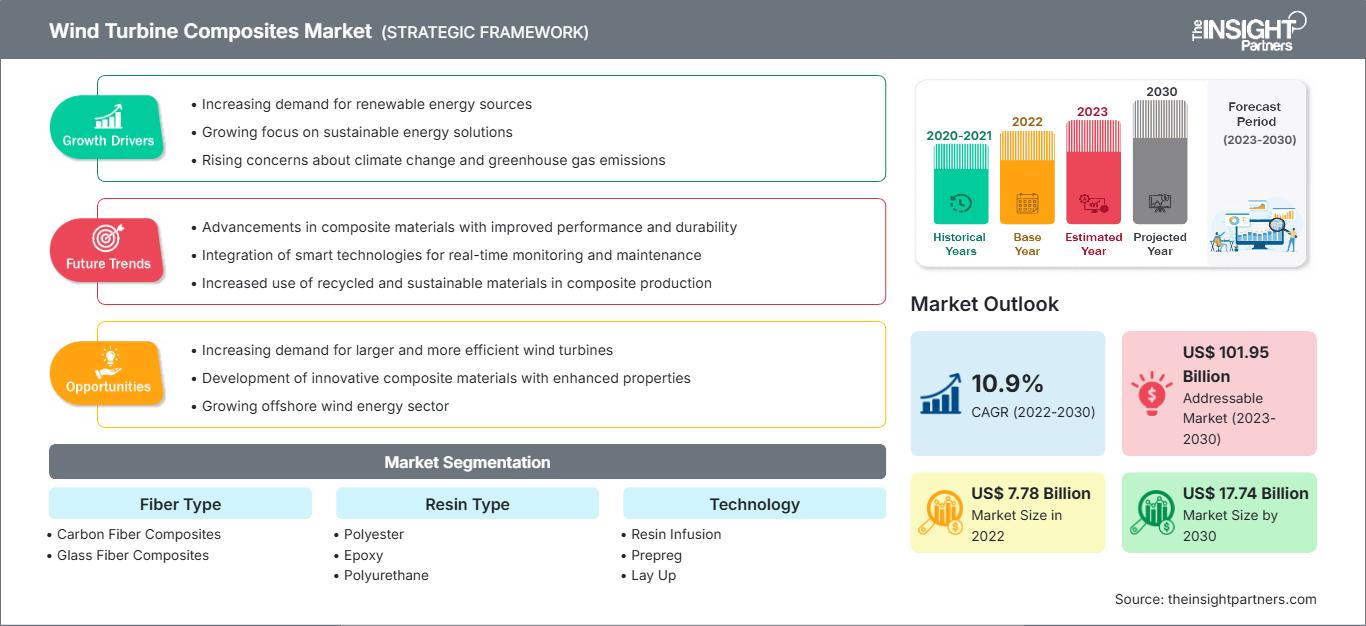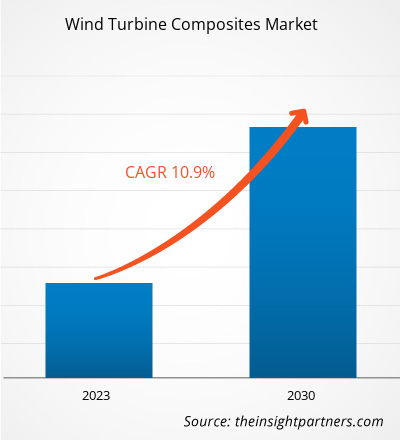[연구 보고서] 풍력 터빈 복합재 시장 규모는 2022년 77억 7,737만 달러로 평가되었으며, 2030년에는 177억 4,086만 달러에 이를 것으로 전망됩니다. 2022년부터 2030년까지 연평균 성장률(CAGR) 10.9%를 기록할 것으로 예상됩니다.
시장 분석
풍력 터빈 복합재는 블레이드 및 나셀과 같은 풍력 터빈 부품 생산에 사용되는 복합재 또는 부품으로 정의됩니다. 복합재를 사용하면 우수한 특성, 낮은 유지 보수 비용, 내식성 및 긴 제품 수명을 가진 경량 부품을 생산할 수 있습니다. 재생 에너지에 대한 관심 증가, 다양한 최종 사용 산업의 풍력 터빈 복합재 수요 증가, 그리고 풍력 에너지 프로젝트 지원을 위한 정부의 긍정적인 노력은 향후 몇 년간 세계 시장에서 풍력 터빈 복합재 수요를 증가시킬 것으로 예상되는 몇 가지 요인입니다.
성장 동력 및 과제
풍력 발전은 연료를 연소하거나 대기 오염 없이 전기를 공급하는 깨끗하고 재생 가능한 에너지원으로 간주됩니다. 풍력 에너지는 화석 연료 의존도를 낮추는 데 도움이 됩니다. 따라서 여러 국가에서 풍력 에너지에 대한 관심이 높아지고 있으며, 이는 설비 용량의 빠른 증가로 이어졌습니다.
아래 그림에 따르면, 2020년 전 세계 신규 풍력 발전 설비 용량은 90GW를 넘어섰으며, 2019년 대비 53% 증가했습니다. 그 결과 총 설비 용량은 743GW로 전년 대비 14% 급증했습니다. 2020년 육상 풍력 발전소의 신규 설비 용량은 86.9GW, 해상 풍력 발전소는 6.1GW에 달하여, 2020년은 육상 및 해상 풍력 발전소 신규 설비 용량 역사상 각각 최고 및 두 번째로 높은 해가 되었습니다.
글로벌 풍력 에너지 협의회(Global Wind Energy Council)에 따르면, 미국은 2020년에 풍력 터빈 용량을 다른 어떤 해보다 확대했습니다. 미국 풍력 산업은 2021년에 풍력 용량을 13,413MW 증가시켜 누적 135,886MW에 도달했습니다. 이는 2020년에 이어 미국에서 단일 연도에 설치된 풍력 발전 용량으로는 두 번째로 높은 수치입니다. 전 세계 여러 국가 정부 또한 생산세액공제(PTC)를 통해 납세자의 급여에 막대한 보조금을 지급하는 방식으로 풍력 발전을 지원하고 있습니다. 따라서 대부분의 재생에너지 산업은 정부의 보조금과 납세자의 지속적인 지원에 크게 의존하고 있습니다. 그러나 이러한 풍력 발전 설비의 대부분은 시장에서 경제성이 없어 끝없는 보조금의 악순환에 빠지게 됩니다. 또한, 정부의 보장된 보조금과 수익의 도움 없이 재생에너지 산업은 신뢰성, 효율성, 그리고 비용 효율성을 개선하기 위한 혁신에 집중하고 있습니다. 따라서 풍력 에너지는 정부 보조금과 세금 환급에 크게 의존하고 있으며, 이는 시장 성장을 저해합니다.
요구 사항에 맞게 이 보고서를 사용자 정의하십시오.
이 보고서의 일부, 국가 수준 분석, Excel 데이터 팩을 포함하여 모든 보고서에 대한 사용자 정의를 무료로 받을 수 있을 뿐만 아니라 스타트업 및 대학을 위한 훌륭한 제안 및 할인을 이용할 수 있습니다
풍력 터빈 복합재 시장: 전략적 통찰력

-
이 보고서의 주요 주요 시장 동향을 확인하세요.이 무료 샘플에는 시장 동향부터 추정 및 예측에 이르기까지 데이터 분석이 포함됩니다.
보고서 세분화 및 범위
"2030년까지의 세계 풍력 터빈 복합재 시장 전망"은 세계 풍력 터빈 복합재 시장 동향과 기회에 중점을 둔 전문적이고 심층적인 연구입니다. 이 보고서는 섬유 유형, 수지 유형, 기술, 응용 분야 및 지역을 기반으로 한 상세한 시장 세분화를 통해 시장 개요를 제공하는 것을 목표로 합니다. 세계 풍력 터빈 복합재 시장은 최근 높은 성장을 기록해 왔으며, 예측 기간 동안 이러한 추세가 지속될 것으로 예상됩니다. 이 보고서는 주요 지역 및 국가의 수요와 함께 전 세계 풍력 터빈 복합재 사용에 대한 주요 통계를 제공합니다. 또한 주요 지역 및 국가의 풍력 터빈 복합재 시장 성과에 영향을 미치는 다양한 요인에 대한 정성적 평가를 제공합니다. 또한 주요 시장 참여 기업과 그들의 주요 전략 개발에 대한 포괄적인 분석을 포함합니다. 시장 역학에 대한 여러 분석도 포함되어 주요 추진 요인, 시장 동향, 그리고 수익성 있는 풍력 터빈 복합재 시장 기회를 파악하는 데 도움을 줍니다. 이는 결국 주요 수익원을 파악하는 데 도움이 될 것입니다.
또한, 생태계 분석과 포터의 5가지 힘 분석은 전 세계 풍력 터빈 복합재 시장에 대한 360도 관점을 제공하여 전체 공급망과 시장 성장에 영향을 미치는 다양한 요인을 이해하는 데 도움이 됩니다.
세분화 분석
전 세계 풍력 터빈 복합재 시장은 섬유 유형, 수지 유형, 기술 및 응용 분야를 기준으로 분류됩니다. 섬유 유형별로는 탄소 섬유 복합재, 유리 섬유 복합재 등으로, 수지 유형별로는 폴리에스터, 에폭시, 폴리우레탄, 비닐 에스테르 등으로 분류됩니다. 기술 측면에서는 수지 주입, 프리프레그, 레이업 등으로 분류됩니다. 시장은 용도별로 블레이드와 나셀로 구분됩니다.
섬유 종류별로 보면, 유리 섬유 복합재 부문은 2022년 세계 풍력 터빈 복합재 시장에서 상당한 점유율을 차지했습니다. 유리 섬유 복합재는 유리 섬유로 강화된 열경화성 플라스틱 수지입니다. 유리 섬유 복합재는 다양한 제조 기술로 생산되며 광범위한 분야에 사용됩니다. 유리 섬유는 고강도, 유연성, 내구성, 내화학성 등 여러 가지 특성을 가지고 있으며, 로빙, 초핑 스트랜드, 원사, 직물, 매트 등의 형태로 제공됩니다. 수지 종류별로는 에폭시 부문이 2022년 세계 풍력 터빈 복합재 시장에서 가장 큰 점유율을 차지했습니다. 에폭시 수지는 경화 과정에서 높은 강도와 낮은 수축률을 보입니다. 뛰어난 인성과 내화학성으로 블레이드 제조에 널리 사용됩니다. 에폭시 수지는 제형에 따라 유리 섬유 또는 복합재 구조의 주조, 수지 바인더, 포팅제, 라미네이팅 수지로 사용됩니다. 기술 측면에서는 수지 주입(resin-infusion) 부문이 2022년 풍력 터빈 복합재 시장을 장악했습니다. 수지 주입 성형 공정은 복잡한 에어포일 형상, 대형 크기, 그리고 비용 효율성으로 인해 대형 열경화성 복합재 풍력 로터 블레이드 생산에 광범위하게 사용됩니다. 수지 주입 기술의 도입은 풍력 터빈 복합재의 품질 향상에 기여했습니다. 응용 분야별로는 블레이드 부문이 2022년 시장 점유율 1위를 차지하며 세계 풍력 터빈 복합재 시장을 선도했습니다. 풍력 터빈 블레이드는 풍력 에너지를 활용하고 풍력 터빈의 로터를 구동하는 에어포일 형태의 블레이드로 정의됩니다. 에어포일 형태의 설계는 블레이드에 풍향에 수직인 양력을 가합니다. 풍력 터빈 블레이드는 풍력 터빈에서 가장 중요하면서도 중요한 부분으로 간주됩니다.
지역 분석
이 보고서는 북미, 유럽, 아시아 태평양(APAC), 중동 및 아프리카(MEA), 중남미 등 5개 주요 지역의 글로벌 풍력 터빈 복합재 시장에 대한 자세한 개요를 제공합니다. APAC 지역은 글로벌 풍력 터빈 복합재 시장 점유율에서 상당한 부분을 차지했으며, 2022년에는 미화 30억 달러 이상의 가치를 기록했습니다. 아시아 태평양 지역의 풍력 터빈 복합재 시장은 호주, 중국, 인도, 일본, 한국, 그리고 기타 아시아 태평양 지역으로 구분됩니다. 중국은 이 지역 시장 성장에 크게 기여하고 있으며, 10년 이상 전 세계에서 가장 크고 빠르게 성장하는 재생 에너지 생산국으로 자리매김해 왔습니다. 유럽 또한 2030년까지 약 40억 달러에 달하는 주목할 만한 성장을 보일 것으로 예상됩니다. 유럽 풍력 터빈 복합재 시장은 독일, 프랑스, 이탈리아, 영국, 러시아 및 기타 유럽 국가로 구분됩니다. 이 지역의 여러 국가는 지속가능성 목표를 달성하기 위해 기술력을 활용하고 있습니다. 또한 북미 지역에서는 풍력 터빈 복합재 사용이 널리 확산되어 풍력 터빈 복합재 시장에 수익성 있는 기회가 창출되었습니다. 북미 풍력 터빈 복합재 시장은 2022년부터 2030년까지 연평균 성장률(CAGR) 약 11%로 성장할 것으로 예상됩니다.
산업 발전 및 미래 기회
파트너십, 인수 및 신제품 출시는 글로벌 풍력 터빈 복합재 시장에서 활동하는 기업들이 채택하는 몇 가지 주요 전략입니다.
2022년 4월, Avient Corporation은 DSM Protective Materials를 인수하여 Dyneema 브랜드와 고유한 기술을 Avient에 추가한다고 발표했습니다. 이번 인수는 성장하는 복합소재 포트폴리오를 확장하기 위한 것이었습니다. Avient Corporation은 또한 Avient Distribution 사업부 매각 방안을 모색할 계획이라고 발표했습니다.
COVID-19 팬데믹의 영향/지정학적 시나리오의 영향/경기 침체의 영향
COVID-19 팬데믹으로 인한 봉쇄, 여행 제한, 사업 중단은 전 세계 여러 국가의 경제와 산업에 악영향을 미쳤습니다. 이 위기는 공급망, 제조 활동, 납품 일정, 필수 및 비필수 제품 판매에 차질을 빚었습니다. 이러한 차질로 인해 풍력 터빈 복합소재의 공급이 제한되었습니다. 생산 지연과 비용 증가로 인해 풍력 터빈 복합소재의 전반적인 공급에 부정적인 영향을 미쳤습니다. COVID-19 팬데믹 기간 동안 봉쇄 조치를 준수하고 근로자의 안전을 확보하기 위해 많은 제조 시설이 일시적으로 가동 중단되거나 규모를 축소했습니다. 또한, 팬데믹은 세계 경제에 영향을 미쳐 원자재 가격 변동과 수지 및 섬유 수요 감소로 이어졌습니다.
각국 정부가 제한 조치를 완화하면서 세계 시장은 손실에서 회복하고 있습니다. 각국이 팬데믹에서 점진적으로 회복하고 백신 접종 노력이 지속됨에 따라 제조 활동이 회복되고 있습니다. 제조업체는 공급 부족을 극복하기 위해 최대 가동률을 허용받고 있습니다. 여러 지역에서 인프라 투자 확대와 경기 부양책이 복합재 수요를 견인하고 있습니다. 따라서 예측 기간 동안 세계 풍력 터빈 복합재 시장은 크게 성장할 것으로 예상됩니다.
풍력 터빈 복합재 시장The Insight Partners의 분석가들은 예측 기간 동안 풍력 터빈 복합재 시장에 영향을 미치는 지역별 동향과 요인을 면밀히 분석했습니다. 이 섹션에서는 북미, 유럽, 아시아 태평양, 중동 및 아프리카, 그리고 중남미 지역의 풍력 터빈 복합재 시장 부문 및 지역별 현황도 살펴봅니다.
풍력 터빈 복합재 시장 보고서 범위
| 보고서 속성 | 세부 |
|---|---|
| 시장 규모 2022 | US$ 7.78 Billion |
| 시장규모별 2030 | US$ 17.74 Billion |
| 글로벌 CAGR (2022 - 2030) | 10.9% |
| 이전 데이터 | 2020-2021 |
| 예측 기간 | 2023-2030 |
| 다루는 세그먼트 |
By 섬유 종류
|
| 포함된 지역 및 국가 |
북미
|
| 시장 선도 기업 및 주요 회사 프로필 |
|
풍력 터빈 복합재 시장 참여자 밀도: 비즈니스 역학에 미치는 영향 이해
풍력 터빈 복합재 시장은 소비자 선호도 변화, 기술 발전, 그리고 제품의 이점에 대한 인식 제고 등의 요인으로 인한 최종 사용자 수요 증가에 힘입어 빠르게 성장하고 있습니다. 수요가 증가함에 따라 기업들은 제품 라인업을 확장하고, 소비자 니즈를 충족하기 위한 혁신을 추진하며, 새로운 트렌드를 적극 활용하고 있으며, 이는 시장 성장을 더욱 가속화하고 있습니다.

- 을 얻으세요 풍력 터빈 복합재 시장 주요 주요 플레이어 개요
경쟁 환경 및 주요 회사
Avient Corp, Toray Industries Inc, SGL Carbon SE, Owens Corning, Gurit Holding AG, Hexion Inc, Hexcel Corp, Exel Composites Oyj, EPSILON Composite SA, Covestro AG는 글로벌 풍력 터빈 복합재 시장에서 활동하는 몇몇 주요 기업입니다.
- 과거 분석(2년), 기준 연도, CAGR을 포함한 예측(7년)
- PEST 및 SWOT 분석
- 시장 규모 가치/거래량 - 글로벌, 지역, 국가
- 산업 및 경쟁 환경
- Excel 데이터세트
최근 보고서
관련 보고서
사용 후기
구매 이유
- 정보에 기반한 의사 결정
- 시장 역학 이해
- 경쟁 분석
- 고객 인사이트
- 시장 예측
- 위험 완화
- 전략 기획
- 투자 타당성 분석
- 신흥 시장 파악
- 마케팅 전략 강화
- 운영 효율성 향상
- 규제 동향에 발맞춰 대응






















 무료 샘플 받기 - 풍력 터빈 복합재 시장
무료 샘플 받기 - 풍력 터빈 복합재 시장